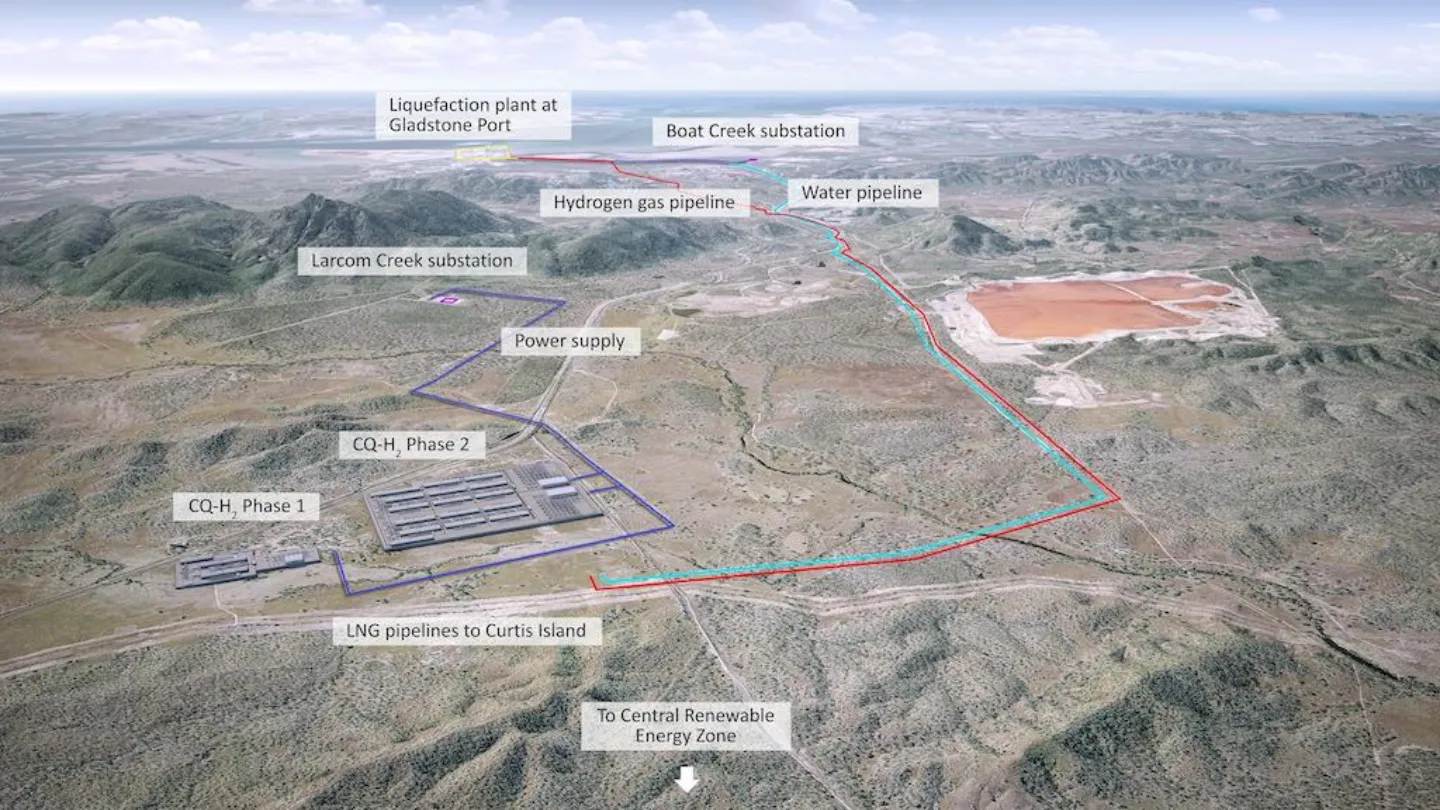Central Queensland Hydrogen Project (CQ-H2) is a hydrogen production facility proposed to be developed in Queensland, Australia.
The project will be developed by a consortium led by government-owned electricity company Stanwell Corporation.
Other partners include Iwatani Corporation, Kansai Electric Power Company, Marubeni Corporation, and Keppel Infrastructure.
CQ-H2 is expected to be developed in phases and may produce up to 292,000 tonnes of hydrogen annually by 2031.
Once operational, the hub will supply hydrogen for domestic use and for exports. The gaseous renewable hydrogen can also be converted to ammonia and liquefied hydrogen for deliveries.
CQ-H2 Location
CQ-H2 is planned to be developed at Aldoga, near Gladstone, in Queensland.
A 236-hectare site was selected as the preferred location for the project due to its proximity to port, power, and pipeline infrastructure.
CQ-H2 Project Development Timeline
A concept study for the development of a large-scale renewable hydrogen hub in Central Queensland from June to October 2020.
Stanwell conducted a joint planning study with Iwatani from November 2020 to August 2021 for the facility.
In April 2021, Stanwell secured land for the proposed renewable hydrogen electrolysis facility at Aldoga.
This was followed by the signing of the Memorandum of Understanding (MoU) with the CQ-H2 consortium and the commencement of the feasibility study in September 2021. The project was received funding from the Japanese Government’s Ministry of Economy, Trade and Industry (METI) for the feasibility study.
Australian Renewable Energy Agency (ARENA) awarded a funding of A$2.17m for the feasibility study.
The detailed feasibility study was completed in June 2022.
The Front End Engineering Design (FEED) of the project began in May 2023. The hydrogen production project received FEED funding of A$15m through the Queensland Renewable Energy and Hydrogen Jobs Fund from the state government and A$20m from ARENA.
Overall, the FEED study has received a commitment of A$117m ($78.65m) from government and consortium partners making it the largest investment to date in an Australian renewable hydrogen project of its kind to date.
During the FEED study, the technical, commercial, and social requirements will be finalised to enable the Final Investment Decision (FID).
It was also shortlisted for the Australian Government’s A$2bn Hydrogen Headstart Program in December 2023.
In October 2023, the Australian Government provided an A$69.2m grant to support the development of the CQ-H2 Project.
The project filed Primary applications for Environmental Protection and Biodiversity Conservation (EPBC) approval in June 2024.
The FID on CQ-H2 is slated to be taken in mid-2025.
Commercial operations for the initial phase project are expected to begin in 2029, and final phase in 2031.
CQ-H2 Project Details
The CQ-H2 project will involve the development of a Hydrogen Production Facility (HPF), a storage facility, a hydrogen gas pipeline to transport the production to the port, and a Hydrogen Liquefaction Facility (HLF).
The project will also include the development of ship loading facilities and an ammonia production facility at Gladstone Port.
Green hydrogen will be produced using water via the process of electrolysis. During electrolysis, a strong electrical current is passed through purified water to split it into hydrogen and oxygen.
The HPF will use electricity generated from renewable energy sources to deliver hydrogen, such as wind and/or solar power to produce hydrogen.
In the first phase, the installed electrolyser size will be 720MW. This will enable an average hydrogen production of 200 tonnes per day.
After the ultimate scale becomes operational, the planned capacity will touch 2880MW, supporting production of 2,880 tonnes per day.
The 23km-long Hydrogen Gas Pipeline will transport hydrogen from the facility to the two offtake facilities at the Gladstone Port- the Hydrogen Liquefaction Facility and Ammonia Production Facility via the Gladstone State Development Area.
The Hydrogen Liquefaction Facility will liquefy gaseous hydrogen before delivery to domestic and overseas markets, while the Ammonia Production Facility will use gaseous hydrogen as a feedstock to produce renewable ammonia.
The ship loading facilities at Gladstone Port will be used to export both liquid hydrogen and ammonia.
The CQ-H2 project is expected to export renewable hydrogen to Japan and Singapore, as well as large domestic customers in Central Queensland.
Over its 30-year operational life, the project is estimated to deliver more than A$17.2bn in hydrogen exports and A$12.4bn to Queensland’s gross domestic product.
It will also create up to 8,900 new Queensland jobs in construction, heavy manufacturing, and other local service industries.
Contracts and Agreements
Arche Energy provided engineering management services to the Pre-feasibility Study (PFS) phase of the CQ-H2 Project.
A MoU was signed with Incitec Pivot Limited (IPL) in May 2023 to explore the development of a green ammonia production facility.
In September 2023, consultant company Worley won the front-end engineering and design (FEED) work for the CQ‑H2 Project. The company also worked as a technical advisor during the initial feasibility study phase.
In October 2023, Stanwell signed a 15-year, 380MW Power Purchase Agreement (PPA) with ACCIONA Energía to buy 100% of the output from its planned Aldoga Solar Farm.
The Aldoga Solar Farm, situated 20km north-west of Gladstone, will supply its output to the CQ-H2 Project.





